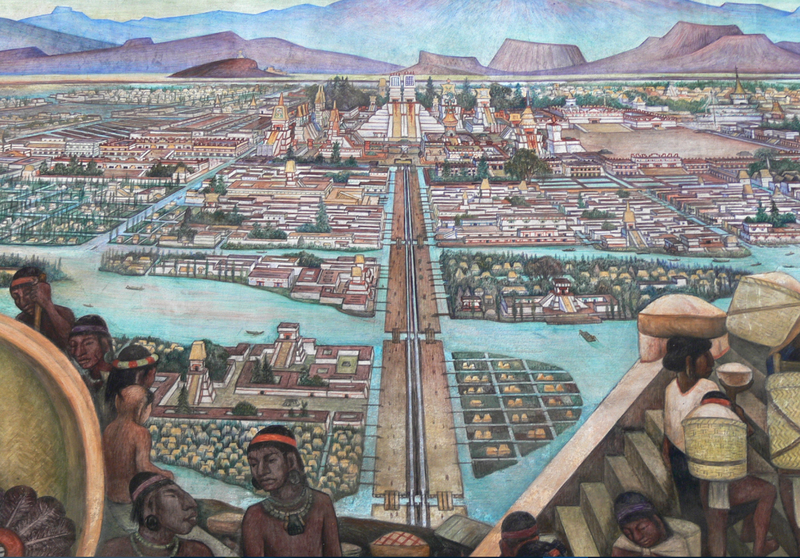Indigenous Peoples of Mexico
What city does this picture depict? This is Tenochtitlan, the biggest and most fluorescent city of Mesoamerica (today Mexico) in the XIV century!
According to legend, the Mexica people founded Tenochtitlan after leaving their homeland of Aztlan at the direction of their God, Huitzilopochtli. Huitzilopochtli asked them to build their future whenever they saw an eagle perched on a cactus, eating a snake. When they saw that exact scene on an island (located in what was once Lake Texcoco), they interpreted it as a sign from their god and founded Tenochtitlan. It was 1325 C.E. Within a few years it would have become the capital city of the greatest Aztec Empire.
Contemporarily, Honduras and Guatemala were the land of Maya Civilization while Ecuador, Bolivia, and Peru were inhabited by the Incas. Together they lived in peace, developing a great system of agriculture while becoming experts in astronomy and mathematics. (For example, they discovered an extremely complicated 260 days calendar based on a cosmic order!)
A Genevan man called Cristoforo Colombo eventually heard of this incredible land and first arrived in the New World in 1492. Europeans colonized the indigenous peoples there, sometimes by creating a cooperative agreement but more often by submitting them to slavery or eliminating them with the transmission of illnesses.
Nonetheless, the colonizers underestimated nature. This was ultimately the indigenous people’s land, and even if it was only a small number, some of them managed to hide in the forest and keep traditions alive. This is part of why indigenous people are still hugely present in Latin America, especially Mexico.
According to the Instituto Nacional de los Pueblos Indígenas (INPI) the majority of the indigenous population is concentrated in the southern and south-central region of Mexico. Over two fifths (42.6 percent) of those who speak an indigenous language live in five of Mexico’s 31 states:
Oaxaca with 1,165,186 indigenous language speakers, accounting for 34.2% of the state's population
Yucatán with 537,516 indigenous language speakers, accounting for 30.3% of the state's population
Chiapas with 1,141,499 indigenous language speakers, accounting for 27.2% of the state's population
Veracruz with 644,559 indigenous language speakers, accounting for 9.4% the state's population
Puebla with 601,680 indigenous language speakers, accounting for 11.7% of the state's population.
Due to the enormous amount of indigenous tribes, which are all regulated under an agreement law called Usos y Costumbres, official statistics define the indigenous population using criteria based on language.
Some of them are:
Zapotec: There are four basic groups of Zapotecs: the istmeños, who live in the southern Isthmus of Tehuantepec; the serranos, who live in the northern mountains of the Sierra Madre de Oaxaca; the southern Zapotecs, who live in the southern mountains of the Sierra Sur; and the Central Valley Zapotecs, who live in and around the Valley of Oaxaca.
Mixtec: They are primarily farmers who practice slash-and-burn cultivation and use the hoe and digging stick or oxen and the plow. Corn (maize), beans, and squash are the staple crops. Other subsistence activities are hunting, fishing, herding, gathering wild foods, and producing and selling items of woven palm fiber. Settlement patterns vary; there are central villages and there are dispersed villages with family groups living scattered over the countryside.
Mazateco: The Mazatec language has a unique and complex sound system. Many words are distinguished only by subtle changes in tone, combinations of consonants which include aspirated and pre-aspirated consonants as well as glottalized consonants. There is also a contrast between nasal and oral vowels.
Chatinos: The region that the Chatinos inhabit is rich in natural resources. Traditionally many Chatino people have been involved in agriculture, which depends very much on the climate, so some Chatinos have had to emigrate to the corners of the district of Juquila to work on coffee plantations. They believe in the Holy Grandmother, the Holy Father Sun, the Holy Mother Earth, and the Holy Mother Moon. In addition, they worship the deities of water, wind, rain, the mountain, and fire.
Each of them has unique linguistic and social traditions which have survived a history of European's colonization and civil wars.
Moreover, there is one main reason which explains the unique individuality of each tribe: geography! According to the Instituto Nacional de Estadística y Geografía (INEGI), Oaxaca 's fragmentation is enhanced by Sierra Madre del Sur, Cordillera Centroamericana and Llanura Costera del Golfo Sur. Nature allowed sixteen ethnic groups within the region to keep their individual language, customs and ancestral traditions intact.
Today, indigenous people across Latin America and especially Mexico are still fighting for recognition and rights. Huge steps forwards have been made: internationally they are fully represented by United Nations Permanent Forum on Indigenous Issues (CDI), and nations are creating programs, parties, and associations to support the indigenous groups.
Mexico adopted the UN Declaration on the Rights of Indigenous Peoples in 2007. However, many issues — including the failure of the government to connect with tribal authorities — persist, sparking protests among indigenous people.
Yet, the strength and resilience to fight for tradition and rights, which has always been a defining feature of indigenous communities, will invariably provide them love, happiness and freedom.
Sources:
https://www.history.com/topics/latin-america/oaxaca
https://www.britannica.com/place/Oaxaca-state-Mexico
https://en.wikipedia.org/wiki/Indigenous_people_of_Oaxaca#Chinantec


